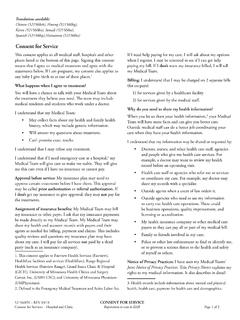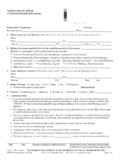Transcription of Edema in the Head and Neck - fvfiles.com
1 Page 1 of 4 Edema in the Head and NeckWhat is Edema ? Edema is swelling caused by the build-up of fluid in the body tissues. This fluid, called lymph fluid, bathes all the cells in the body. Normally, the lymph system (a network of nodes and vessels) removes any extra fluid and returns it to the bloodstream. But when part of the lymph system is damaged or doesn t work right, the fluid is not removed. Instead, it keeps building up until swelling occurs. Swelling often appears in the head, face, neck , arms, legs or trunk. There is no cure for it, but it can be controlled. There are two kinds of Edema : Primary Edema is caused by a problem in the lymph system that is present at birth. The swelling may exist at birth or develop later in life. It occurs more often in Edema results from a known injury to the lymph system. It may be due to surgery, injury, scarring, chronic vein problems, radiation treatment, obesity (being very overweight) or repeated infections.
2 Cancer patients who have their lymph nodes removed or radiated are at higher risk for Edema . It may occur right after cancer therapy or many years doctor may think you re at risk for Edema , or you may already have it. In either case, you should ask to meet with a certified Edema therapist. What are the symptoms?Early symptoms may be subtle: You may have a tight or full feeling in the head or neck area, including the nose, tongue or mouth. You may have no swelling that you can see. Or swelling may appear at the start of the day and lessen or go away by evening. Symptoms tend to get worse without treatment. The skin and soft tissues of the face and neck may lose their elasticity (ability to stretch) and may harden (fibrosis). Your chances of getting skin infections, such as cellulitis, increase. If it is not treated, Edema progresses in three stages: Stage 1: Swelling goes away if you remain upright for several hours. Stage 2: Swelling does not go away completely.
3 The skin on your face or neck gets harder. You may have skin infections, increasing the risk that you will move to Stage 3. Stage 3: Extreme swelling may occur. The skin becomes thicker and loses its you are deaf or hard of hearing, please let us know. We provide many free services including sign language interpreters, oral interpreters, TTYs, telephone amplifiers, note takers and written 2 of 4If your neck is swollen, driving may be a problem, as it will be hard to turn your head from side to side. If swelling affects the eyelids or nose, you may have problems seeing or breathing. If you have a dry mouth from cancer treatment, swelling could make it harder to eat and talk. How can I prevent or control Edema ?You may help prevent Edema by following the guidelines below. If you already have it, these steps may keep your swelling from getting worse. But they cannot replace treatment by a certified therapist. Take care of your skin The extra fluid in your head and neck creates a site where germs can easily multiply.
4 Try to avoid any breaks in the skin such as cuts, insect bites, burns or scratches. A break in the skin can let germs into the body and put the swollen body part at risk for infection. If skin breaks occur, you will need to treat them quickly. Always wash cuts and injuries right away. Carry an anti-bacterial cream (Neosporin, Polysporin, bacitracin) and some Band-Aids to cover any wounds. Keep your head and neck clean and dry. Be sure to follow good mouth care as advised by your doctor. Take extra care when shaving. Protect skin with sunscreen (at least 30 SPF) and insect repellent. Don t let your skin get too oily, dry or chapped. Use scent-free, color-free soap and lotion, such as Nivea, Curel, Eucerin or Lubriderm. Put the lotion on right after bathing. Use it more often if you notice any dryness. Daily lotion will help prevent chapping or chaffing of the skin. If possible, do not allow body piercings, acupuncture, tattoos or other procedures on your head and neck area.
5 If you have an itch, do not scratch your skin. Instead, gently rub over the area with a cold, wet washcloth. Call your doctor at once if you notice any redness, pain, heat or swelling in your head or neck area (even in small amounts), or if you have a fever. These symptoms may be a sign of extreme hot or coldHeat will cause blood vessels to dilate (grow wider). This increases the amount of fluid in the tissues. Extreme cold will cause vessels to constrict (become narrow). This decreases the flow of fluid. Both heat and cold can make swelling worse, though heat is often worse than cold. Avoid long, hot showers and baths. Stay away from saunas and hot tubs. Avoid extreme cold on your head and neck . (For example, don t use an ice pack.) This may cause swelling and chapped your position during sleepUse a pillow to keep your head from turning. Place another pillow under your knees to prevent rolling. If swelling is worse when you wake up but improves when you are up and about, try raising the head of your bed.
6 Exercise safelyExercise helps move lymph fluid back into your body, but be careful not to overdo it. If you had surgery or radiation, you may have a lot of scarring. This can restrict the motion in your neck , jaw and shoulders. Page 3 of 4 Begin with gentle range-of-motion exercises. Your doctor or therapist will show you what to do. Do moderate exercise, but don t get overheated or too sweaty. During and after exercise, check for any changes in your head and neck . If you notice increased swelling, place a moist, cool towel on the area. Try to stay at a healthy body t restrict the flow of lymph fluidIf you restrict the flow of the fluid, you are more likely to have swelling. Be sure to wear loose-fitting clothes and jewelry. Your doctor may want you to wear special bandages or compression garments. When properly fitted, these will not restrict the lymph fluid or blood : Bras that cut into your shoulders or torso Sleeves that bind Heavy purses with shoulder healthy habits Eat a healthy diet with plenty of fruits, vegetables and whole grains.
7 Avoid foods that are high in fat or salt. Don t smoke. Use alcohol in moderation. Drink 6 to 8 glasses of water each day to help flush out your system. Take extra care when flying. Air travel can increase swelling. Keep doing your normal activities as much as possible. Talk to your doctor or therapist if you are unsure about an is Edema treated?Your therapist will use a series of treatments called Complete Decongestive Therapy (CDT). This can greatly reduce, or reduce the risk of, swelling in the head and neck . Treatments may include: Manual lymphatic drainage, or gentle massage-like treatment for the head and neck area. This moves fluid from damaged areas to healthy areas where the lymph system works well. Compression bandages or garments to help soften hard tissue, reduce swelling and prevent fluid from building up again. Exercises to help your lymph vessels work better. They will also move fluid out of the swollen areas.
8 Exercises may involve stretching, range of motion and improving posture. Skin care to help prevent infections. Scar massage to help release tight skin tissue. Your therapist will show you how to do this. A home care program. To help control your Edema , your therapist will create a treatment program that meets your specific needs. It may include all or some of the treatments above. Do I need an order to see a therapist?Yes. An order is a prescription for therapy. Your order must come from a doctor who is licensed in Minnesota. After we receive your order, you will have an evaluation by a physical or occupational therapist certified in Complete Decongestive more information about our services, call your Edema Treatment Center. Page 4 of 4 The Lymphatic SystemFor informational purposes only. Not to replace the advice of your health care provider. Image 1994 Guenter Klose. Printed with permission of Klose Training & Consulting, LLC, Boulder, Co.
9 Text copyright 2010 Fairview Health Services. All rights reserved. SMART works 521086 REV 04/16.














